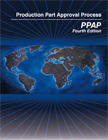We need your consent to use the individual data so that you can see information about your interests, among other things. Click "OK" to give your consent.

Production Part Approval Process
Production Part Approval Process
Translate name
PUBLICATION published on 1.11.2009
Product information:
Designation: Production Part Approval Process
Approximate weight : 300 g (0.66 lbs)
Note: Version: 4th edition, 2nd printing,
Product code: PPAP-4
Publication date: 1.11.2009
Country: American publication
Category: AIAG publications
*) If the goods is not available in stock and must be ordered at the publisher, the actual shipping and handling costs will be added. We will inform you about the details based on your request sent to info@normservis.cz, eventually dialing +420 566 621 759.
Annotation of standard text:
PPAP is the industry standard that defines the production part approval process and demonstrates engineering design records and specification requirements are achieved by the suppliers manufacturing process. The PPAP guideline provides the minimum expectations a supplier must document and submit to a customer for approval to ship production part quantities. NOTE: The PPAP 4th edition, 2nd Printing includes the corrections from the PPAP errata sheet dated July 19, 2006. The PPAP 4th edition, 2nd Printing, does not contain any new PPAP requirements; therefore, PPAP 4th edition and PPAP 4th edition, 2nd Printing are considered technically equivalent and valid editions. />
We recommend:
Technical standards updating
Do you want to make sure you use only the valid technical standards?
We can offer you a solution which will provide you a monthly overview concerning the updating of standards which you use.
Would you like to know more? Look at this page.



 Cookies
Cookies
